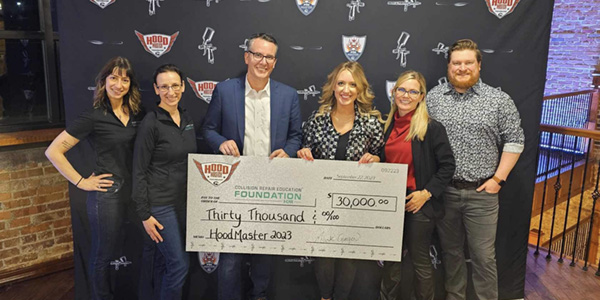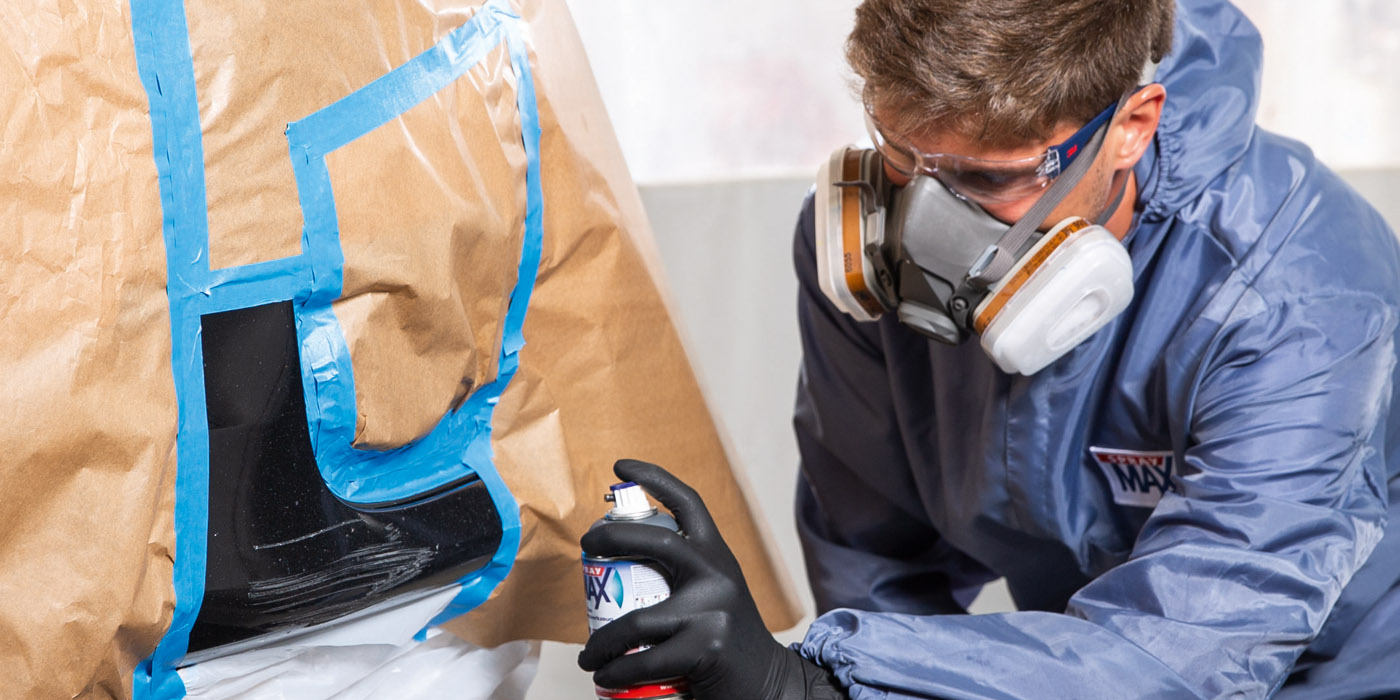
Implementing paint-shop best practices ensures that this department is contributing to the long-term improvement of shop profitability and sales. It also ensures that the jobs coming out of the paint department get done right … the first time. by Jake Snyder
I really enjoy going to NACE. The glitz and hoopla surrounding the convention is a sort of primer for the upcoming holidays, and the exhibitors and attendees, innovative systems, educational sessions and keynote speakers get me pumped up as I ready myself for the New Year.
Usually I don’t schedule travel or shop on-site work between NACE and the holidays, but this year, I made an exception and visited a shop. I’d never been to this facility, but I knew it was a high-volume producer with a great local reputation. And, from a preliminary review of its financials, the operation was clearly a top-tier performer.
After arriving at the shop and getting a quick tour of the facility, my holiday spirit and New Year enthusiasm was dampened. Giving best-practice advice is my job, and from what I saw in the paint department, this shop clearly didn’t achieve its financial success by embracing the type of management thinking, processes and standards exhibited at NACE.
For example, the paint shop had four booths and four painters. The area was spacious and uncluttered, but after those two positives, I was unable to identify any commonly accepted best practices. The unfinished brick walls and concrete floors hadn’t been painted or maintained since original construction. Dirt and dust buildup was apparent everywhere, and the four old paint booths looked like they were maintained about as well as the rest of building. It sort of reminded me of a turn-of-the-century sweatshop.
The owner clearly hadn’t put any investment into his dungeon-style paint department for 10 to 15 years. Yet over the past couple of years, shop sales and profits had increased more than 200 percent through management investment and improvement of sale, pre-production and administrative processes. During that time, however, he’d allowed his back-end production processes to actually regress in terms of processes and systems. In fact, the owner and manager readily admitted they didn’t see any value in making immediate changes to the production system.
It’s a common problem. Short-term successes blind management from aggressively seeking new ways to improve production by implementing industry best practices.
This contrast of the “best of the best” exhibited at NACE and this “not the best yet highly profitable” operation is a real-life example of a classic business dilemma: short-term gains vs. long-term investment. Balancing shareholder demand (owners and investors) for maximum short-term profits and wealth, while maintaining long-term business viability and sustaining a competitive advantage, is a challenge faced by all businesses in all industries.
Like every other article I’ve written so far, this one originally was intended to cover a slightly different topic. The original idea was to discuss paint-shop management in terms of paint-shop work flow and paint-repair processing. But after speaking to several industry professionals who are experts in paint-shop management, paint processes, and layout and design, I realized that a best-practices discussion on paint-shop management has to include more than work flow and repair methods.
Everyone I spoke with agreed that there are still too many paint-shop operations out there with great numbers using antiquated and environmentally unsafe equipment or work methods. They also said these kinds of operations are inefficient in a bigger sense — referring to sustainable efficiency over the long term and potential efficiency — and won’t meet growing customer demands. (Potential efficiency is a comparison to performance benchmarks that either don’t exist or are only achieved by so few operations that their exceptional performance has yet to hit everyone’s radar screen.)
Everyone I spoke with also suggested many of the same best practices to improve paint-shop management. These suggestions include planning, training, developing leadership, using available technology, using information and paint-system instructions, cleaning and maintenance, investing to improve work environment, investing to expand building or to relocate, planning and investing long term in place of short-term home runs (or perceived home runs), and implementing process-driven operations rather than employee-driven or reactionary operations.
As you’d expect, my measure of success for a paint-shop operation is based on long-term or continuous improvement — improvement that’s sustainable and responsive to the changing demands of customers, employees, the community and regulatory groups. This measure of success has the best odds of ensuring your shop’s economic survival.
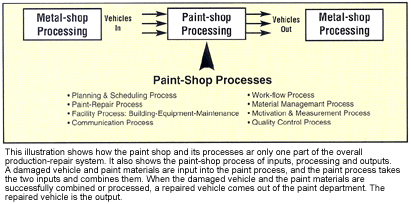
Developing a Paint-Shop Management Process
To get started developing a solid paint-shop management process, you have to understand that the bottom line of paint-shop processing must contribute to improving long-term shop profitability and sales.
Profits are driven by effective operations. Effective operations are:
- Paint-repair processing actions producing quality jobs that meet customer, company, vehicle and industry standards.
- Error-free paint-repair processes requiring minimum rework.
- Efficient paint-repair processing or best use of people, equipment, materials and building spaces.
The majority of body shops today are delivering a superior paint finish back to customers. Training, paint chemistry and customer demand for superior finishes have enabled and forced repairers to deliver a quality product. Unfortunately, only a minority of shops get to the final delivery stage with a process or operating system using industry best practices. Open-air painting or painting in prep stations, finish buffing and sanding of every painted panel, excess quantities of mixed paint, redos or rework, work delays, poor equipment performance and unfriendly work environments are but a few examples of unacceptable — but common — operating practices. Replacing these unacceptable practices with best practices will result in a more profitable paint operation.
Sales are driven by increasing customer demand for collision-repair services and by producing more services to meet that demand. And increasing demand and production output means higher customer satisfaction, increasing the odds of a customer re-purchasing your services and referring new customers to your shop. Increasing production output is simply repair-processing more customer orders.
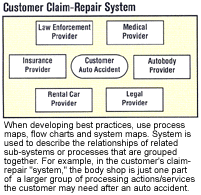
Using best-practice recommendations, improving the bottom line for the paint shop requires a management strategy encompassing more than the best equipment or the best technicians. Management has to distribute time and resources between all of the paint-shop processes that impact paint-shop performance.
Management has to approach paint-shop management improvements on these multiple fronts:
- Planning and scheduling process;
- Work-flow process;
- Paint-repair process;
- Material management process;
- Facility process: building-equipment-maintenance;
- Motivation and measurement process;
- Communication process; and
- Quality control process.
The challenge is to maintain a focus on all areas. The paint department I saw after NACE had four painters and four booths in a very large area. This enabled the paint department to carry a vary large work-in-process (WIP) inventory of vehicles, while giving the impression that there were no bottlenecks in the paint shop. But, in reality, the WIP vehicle inventory in the paint department was too high (bottleneck) based on the average quantity of cars delivered daily. Instead of the four painters working as a single team or in two teams that focused on prepping and painting cars in a priority and sequence in which they arrived in the paint shop, the four painters were accumulating and prioritizing jobs independent of each other and without consideration for helping or assisting their co-workers to get jobs painted faster and with better quality. The shop’s management was committed to providing space and equipment, but neglected to address the other paint processes related to maintenance, work flow, efficiency or utilization of equipment and labor, teamwork and on-time delivery.
Create a Process Mentality
Process analysis begins when you understand the shop processing steps that are needed to satisfy customer and management expectations. System and process mapping is the only way to fully analyze how your business processes interact — or should interact — to assure operations can meet and exceed customer and company expectations.
Sitting down with a piece of paper and pencil to draw squares and arrows is something everyone can do and is the best way to analyze operations. Process mapping sounds sophisticated — and it is — but not because it’s difficult to do. (Do it once, you’ll see that you’re probably pretty good at drawing blocks and arrows. And after you do it, you can boast to friends and colleagues that process-mapping techniques are an integral part of how you analyze and improve operations.)
I guarantee that hand-drawn boxes and arrows are still the best practice used to analyze processes by professionals in all industries. Don’t ever hesitate to say, “I don’t understand. Draw me a picture.” As a matter of fact, you should demand it. If a logical picture can’t be drawn to illustrate relationships, sequence and choices, then you know what? Someone is selling you B.S.
When developing best practices, it’s important to use process maps and flow charts, and for broader issues, system maps. (Sometimes the term “system” is used to describe the relationships of related sub-systems or processes that are grouped together. For example, a body shop creates a physical boundary or box around many internal sub-systems or processes. In the customer’s claim-repair “system,” the body shop is just one part of a larger group of processing actions/services the customer may need after an auto accident. See the diagram called “Customer Claim-Repair System” on page 38.
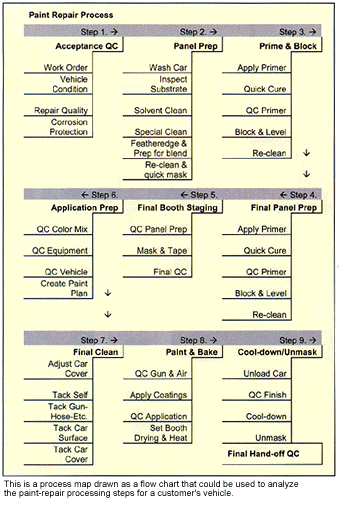
Process mapping breaks down into a system by grouping sub-processes or work actions into work flow and functional relationships. A process and system are defined by inputs, a conversion process and outputs. As a distinction, a procedure is a step-by-step instruction of how to perform a work action. Procedures can be very detailed and are the last level of process analysis.
A body shop houses numerous processes and has numerous inputs and outputs. Inputs to a body shop system are vehicle owners, insurers, suppliers, shop owners, money-lenders, the community, employees and regulatory groups. Outputs are the results from body shop processing and generally satisfy the input owners. Some outputs are repaired cars, settled claims, profits and economic stability.
For example, the “Paint Shop Process” diagram below shows how the paint shop and its processes are a part of the overall production-repair system. The diagram also shows the paint shop process of inputs, processing and outputs. A damaged vehicle and paint materials are input into the paint process, and the paint process takes the two inputs and combines them. When the damaged vehicle and the paint materials are successfully combined or processed, a repaired vehicle comes out of the paint department. The repaired vehicle is the output.
But for the paint shop to effectively output or repair multiple vehicles, more processes have to be added as part of an overall paint-shop process, which includes management, training, maintenance, etc.
Developing Processes
The number and level of detail that work standards must take is dependent on several factors and can vary from body shop to body shop. Some shops may not require as many or as detailed process descriptions and standards as others.
Shops with few employees where management is actively involved in operations need fewer formal process descriptions and written procedures than larger, more complex operations. The familiarity and trust that usually exists in a small organization reduces the chances of operating problems and breakdowns going unnoticed. Problems usually are recognized and addressed as they occur. And in smaller shops where management is working side-by-side with front-line employees, information flow is informal and fast compared to larger shops, where numerous information channels and interpretation filters exist.
There are times, though, when even smaller shops need formal processes and written procedures. For example, a new piece of equipment is purchased, and correct machine use requires the operator to go through a sequence of complicated steps. In this case, the shop will need to have written procedures to use for guidance until everyone learns how to operate the machine effectively. Depending on the people and the complexity or expense of the equipment, a reference copy of the procedures may need to be placed permanently near the machine’s control panel.
Though some shops will require more detailed process descriptions than others, here are some points to consider when deciding when to formalize processes or to implement new processes:
- Failure trends of process: If you have a reoccurring issue or problem, then it may be time to create a formal process or procedure to eliminate the problem. It also may be time for a formal process if the root cause and solution of a problem are uncertain, and you need to test and measure the outcome of process changes by dictating and controlling processing actions.
- Familiarity of process: When a new process is introduced that’s unfamiliar to employees, a formal process description also must be introduced to participants who will be responsible for performing the new process.
- Complexity of process: Does the process have numerous steps or decisions that must be made in order to be done correctly?
- Risk level of process: You need to consider the potentially threatening and costly outcomes if the process isn’t performed according to standards.
- Precision standards: Tight specifications can apply to standards that are demanded by the customer, management, regulatory agencies, materials usage, equipment usage and vehicle manufacturers.
- Size of the organization: The larger your shop, the harder it is to get immediate feedback on process performance accuracy and effectiveness and to resolve compliance or training issues. Formal process descriptions aid management control.
- New employees: Constant employee turnover or new hiring requires continuous and accurate employee education that can’t be left up to informal systems.
- Role of management: If your shop hires and trains managers and staff to be highly motivated, skilled and results-driven performers, less formal processes will be needed to manage operations.
Making Sure Best Practices Are Followed
Once you’ve established work standards, processes and procedures, your next challenge is ensuring that the processes are used consistently by technicians. Several factors influence consistent usage of a best practice:
- Train employees — Ensure that the “who, what, when, where and how” for the new process is clear and understood by employees.
- Have allies on the shop floor — Identify and recruit front-line techs to be process champions. These people understand how the process works and believe the process is valuable. They’ll provide support on the shop floor and immediate feedback to management on process effectiveness.
- Develop a feedback system — A monitoring and feedback system must be used to quickly identify if the processes need to be changed or even abandoned.
- Establish penalties — Non-compliance penalties have to be defined and enforced by management. Caution: This is usually misunderstood and can easily backfire if applied incorrectly. Failure of employees to use or comply with a best practice is, most times, a management issue because management hasn’t done its job on one or more of the other factors.
- Offer support and resources — Management must provide diligent support, leadership and resources to make the new process take hold and produce the expected results. This often takes a lengthy management commitment and constant encouragement and prodding to institutionalize a new best practice into daily operations.
Using Written or Formal Procedures
One reason best practices aren’t consistently followed is the steps for employees to follow don’t provide instruction for when choices must be made. If the prescribed process is incomplete or has too many “exceptions” to the work rule that don’t apply, then employees will conclude that management hasn’t “thought out” the process.
This is common, which is why it’s important to get feedback on the new process and respond quickly with changes to improve the process or abandon it altogether and start over. When introducing a new process, employees and management need to view the new process as a work-in-progress that will likely need revisions.
See the diagram called “Procedure Chart: Acceptance of QC Process For Paint Department.” This example shows one way to address the different choices and decision points. When a paint process or procedure has the possibility of taking different directions based on numerous opportunities for the user to make “if this, then that” decisions, then that process is a candidate for formal, written procedures and training.
For techs to take the right process path, all possible options have to be clearly understood. When if-then options can’t be clearly identified by management and illustrated in a flow chart, then don’t expect technicians to make the right choice at the right moment and under the right circumstances. The process has to dictate the right direction under every circumstance.
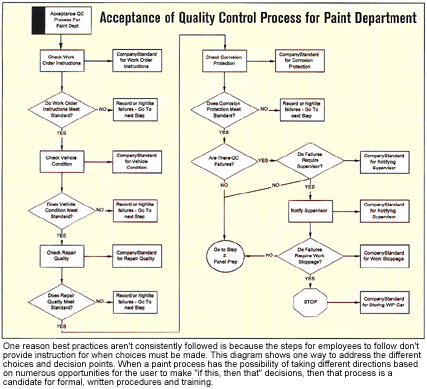
For example, faulty body-filler work that doesn’t meet shop standards is often discovered by preppers in the paint shop. As we all know, this is often a primary area of conflict between body and paint. I can also assure you from hundreds of tech interviews that when this is an issue, it’s demoralizing and management is viewed as not caring about quality, efficiency, employee performance and even the customer.
When any process failure or failure to comply with standards isn’t recognized and immediately resolved by management, techs are correct in concluding that management doesn’t care because management is ignoring a best practice. Too often, management applauds painters or preppers who take the initiative and re-repair faulty filler work in the paint shop instead of holding up production or creating a conflict with metal techs by sending the job back.
Unfortunately, it’s not initiative that drives the paint shop to do the re-repairs. The paint team is fed up with trying to do the right thing and being accused of stirring up the production system.
That is why formal, written best practices in the form of procedures with if-then options and decision points are critical in the production shop. They’re not needed for every little task (it’s actually counter-productive to have too many), but they are needed when the importance of process compliance demands it.
Though it takes some times to get best practices into place, they:
- Improve morale and eliminate debate and opinion;
- Reduce incorrect decision making and dictate the direction of processing paths;
- Improve quality and consistency;
- Focus the technical staff on process improvement; and
- Give management objective evidence and process tools to troubleshoot operating issues.
The trick is to execute best practices in all areas. Just having a best practice in one area — like say, having the best spraybooths, paint guns, etc. — won’t make the whole paint shop perform to its capabilities. The other areas like management, planning, maintenance, processes, etc., also need to be in sync with the equipment capabilities. Everything must work together as a system.
Most paint shops don’t successfully employ all the best practices I’ve discussed in this article. Many do pieces of it well, but they never really combine all paint-shop best practices effectively. To do it requires a lot of work, so many shop owners go the route of immediate gratification instead.
But short-term (though often profitable) strategies suggest minimal investment toward the future. If you’ve opted for this fast cash method, keep in mind that winning the game today — at all costs — usually comes at the expense of your future success.
Writer Jake Snyder is the principle of CR Management Systems, a consulting, training and business-development company. He’s been in the industry for more than 15 years, has managed a collision repair facility, held various claims positions with Allstate Insurance Company, and performed consulting and product development for Body Shop Video’s, Business Development Group. Snyder can be contacted at (732) 886-5340 or at [email protected].










